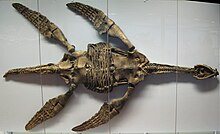Meyerasaurus victor
|
Meyerasaurus Temporal range: Early Jurassic, 183–180 Ma |
|
|---|---|
 |
|
| The holotype in the State Museum of Natural History Stuttgart | |
| Scientific classification | |
| Kingdom: | Animalia |
| Phylum: | Chordata |
| Class: | Reptilia |
| Superorder: | †Sauropterygia |
| Order: | †Plesiosauria |
| Family: | †Rhomaleosauridae |
| Genus: |
†Meyerasaurus Smith & Vincent, 2010 |
| Species: | †M. victor |
| Binomial name | |
|
Meyerasaurus victor (Fraas, 1910 [originally Plesiosaurus]) |
|
| Synonyms | |
|
Plesiosaurus victor Fraas, 1910 |
|
Plesiosaurus victor Fraas, 1910
Thaumatosaurus victor Fraas, 1910
Eurycleidus victor Zittel, 1932
Rhomaleosaurus victor Tarlo, 1960
Meyerasaurus is an extinct genus of rhomaleosaurid known from Holzmaden, Baden-Württemberg of southeastern Germany.
Meyerasaurus is known from the holotype SMNS 12478, articulated and complete skeleton which preserved the skull, exposed in ventral view. The skull has a length of 37 cm (15 in), and the animal is about 3.35 m (11.0 ft) in length. It was collected from the Harpoceras elegantulum-falciferum ammonoid subzones, Harpoceras falcifer zone, of the famous Posidonien-Schiefer lagerstätte (Posidonia Shale), dating to the early Toarcian stage of the Early Jurassic, about 183-180 million years ago.
Meyerasaurus was first named by Adam S. Smith and Peggy Vincent in 2010 and the type species is Meyerasaurus victor. It was originally classified as a species of Plesiosaurus, later as the second named species of Thaumatosaurus (defunct name, meaning "wonder reptile") and ultimately as a species of Eurycleidus or Rhomaleosaurus. The generic name honors the German palaeontologist Hermann von Meyer for proposing the generic name Thaumatosaurus.
...
Wikipedia
